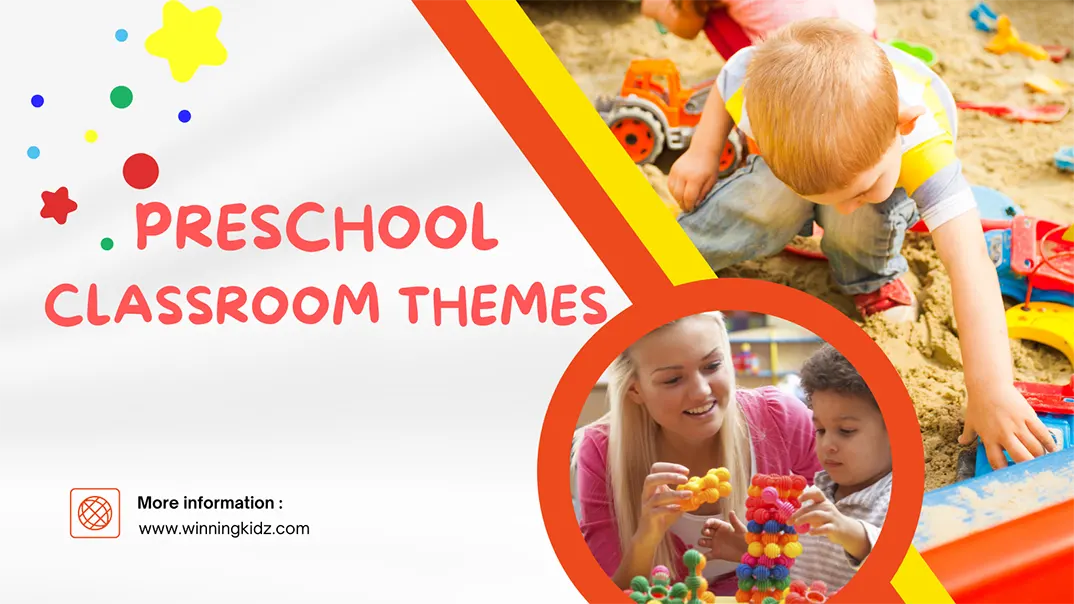Czy zastanawiałeś się kiedyś, jak przedszkolny motyw może przekształcić klasę w magiczną przestrzeń do nauki? Czy kreatywne środowisko może rozbudzić ciekawość i rozwijać kreatywność w młodych umysłach? Czy odpowiedni motyw może być kluczem do uczynienia Twojej przedszkolnej klasy bardziej angażującą i zabawną?
Odpowiednie motywy w klasach przedszkolnych robią więcej niż tylko sprawiają, że pokój jest atrakcyjny — nadają ton nauce, kreatywności i zabawie. Gdy są starannie dobrane, pomagają dzieciom czuć się zainspirowanymi, komfortowo i chętnymi do eksplorowania swojego otoczenia.
W tym poście przyjrzymy się, jak wybrać idealne motywy do zajęć w przedszkolu, które przyciągną uwagę uczniów, wzbudzą w nich miłość do nauki i przyczynią się znacząco do ich rozwoju. Niezależnie od tego, czy jesteś nauczycielem przedszkolnym, dyrektorem szkoły czy rodzicem, znajdziesz praktyczne porady dotyczące włączania motywów do swojej przestrzeni i uczynienia jej naprawdę magiczną.
Jaki jest motyw przewodni zajęć w przedszkolu?
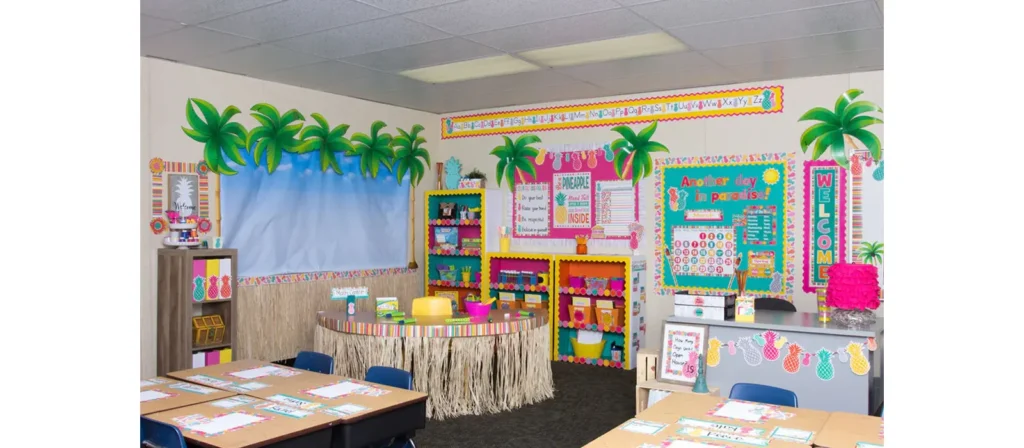
Tematyka klasy przedszkolnej to konkretna, nadrzędna koncepcja lub pomysł, który łączy wystrój klasy, zajęcia i obszary nauki. Może obejmować szerokie idee, takie jak natura lub przestrzeń, lub bardziej szczegółowe koncepcje, takie jak eksploracja podwodna lub konkretna pora roku. Tematy mogą być zintegrowane w całym środowisku edukacyjnym, od dekoracji ściennych i tablic ogłoszeniowych po rodzaje używanych zabawek i zajęć.
Te motywy przedszkolne służą jako ujednolicona rama kształtująca doświadczenie edukacyjne. Może być tak odważna jak przedszkolna tematyka kosmiczna lub tak przytulna jak motyw farmy dla przedszkolnej klasy. Niezależnie od tego, czy jest to pomysł sezonowy, jak jesienne motywy przedszkolne, czy też koncepcja skupiona na dziecku, jak motyw przedszkolnej klasy Dr. Seussa, celem jest stworzenie dynamicznego i interaktywnego środowiska dla przedszkolaków.
Korzyści z motywów zajęć przedszkolnych
Wybór właściwego Temat zajęć przedszkolnych oferuje wiele korzyści, tworząc atrakcyjną przestrzeń i wspierając bogate, edukacyjne środowisko dla młodych uczniów. Nauczyciele mogą tworzyć wciągające, angażujące doświadczenia, które wspierają rozwój poznawczy, społeczny, emocjonalny i fizyczny dzieci, włączając motyw. Oto kilka kluczowych korzyści z używania motywów w klasie przedszkolnej:
Większe zaangażowanie
Zabawny motyw przedszkola zachęca dzieci do eksplorowania otoczenia i aktywnego uczestnictwa w zajęciach. Na przykład, przedszkolna klasa o tematyce cyrkowej może przekształcić naukę w zabawną przygodę. Kiedy dzieci są zanurzone w tematycznym środowisku, ich ciekawość zostaje pobudzona, zachęcając je do głębszego zaangażowania się w zajęcia. Motyw cyrkowy, z jego żywymi kolorami, interaktywnymi przestrzeniami i tematycznymi rekwizytami, takimi jak piłki do żonglowania lub kostiumy klauna, zamienia klasę w dynamiczną przestrzeń edukacyjną. Ekscytacja motywu zachęca dzieci do udziału w opowiadaniu historii, grach i zajęciach fizycznych, wzbogacając ich doświadczenia edukacyjne.
Tematy przyciągają uwagę dzieci i tworzą emocjonalną więź z materiałem, którego się uczą. Na przykład klasa o tematyce kosmicznej może rozbudzić ciekawość wszechświata, co skłoni dzieci do zadawania pytań o planety, gwiazdy i astronautów. To zaangażowanie nie ogranicza się do projektu klasy — rozciąga się na każdą lekcję, sprawiając, że nauka wydaje się przygodą czekającą na rozwinięcie.
Zorganizowane przestrzenie do nauki
Tematy takie jak tęczowe motywy przedszkolne lub motywy oceanu dla klas przedszkolnych pomagają tworzyć spójne wizualnie i zorganizowane środowiska, ułatwiając młodym uczniom nawigację. Dobrze zaplanowane układ klasy oparte na temacie rozbudza ciekawość i zapewnia poczucie struktury. Na przykład klasa o tematyce oceanicznej mogłaby zawierać obszary oznaczone kolorami do różnych zajęć: kącik czytelniczy „akwarium”, stół do zajęć plastycznych „rafa koralowa” i kącik matematyczny „stworzenie morskie”.
Te tematyczne przestrzenie są wizualnie stymulujące i pomagają młodym uczniom odróżniać obszary dla różnych typów aktywności. Tematyczne dekoracje, takie jak tęczowa klasa z skoordynowanymi kolorami sekcjami lub murale oceaniczne na ścianach, zapewniają stymulację sensoryczną i pomagają dzieciom szybko dostosować się do otoczenia. W miarę jak dzieci czują się bardziej komfortowo w wizualnie zorganizowanej przestrzeni, mogą lepiej skupić się na zadaniach, poprawiając swoje zachowania w nauce i zachowania społeczne.
Promuje kreatywność
Podobnie jak w przedszkolu w stylu Disneya, dobrze udekorowana klasa pobudza wyobraźnię i ekspresję artystyczną. Dzieci są zachęcane do uwolnienia swojej kreatywności, gdy w klasie znajdują się elementy tematyczne — księżniczki, superbohaterowie lub dzikie zwierzęta. Na przykład w przestrzeni w stylu Disneya dzieci mogą opowiadać historie, rysować ulubione postacie lub odgrywać ulubione sceny. To środowisko pomaga dzieciom rozwijać ważne umiejętności poznawcze, takie jak rozwiązywanie problemów, komunikacja i myślenie abstrakcyjne.
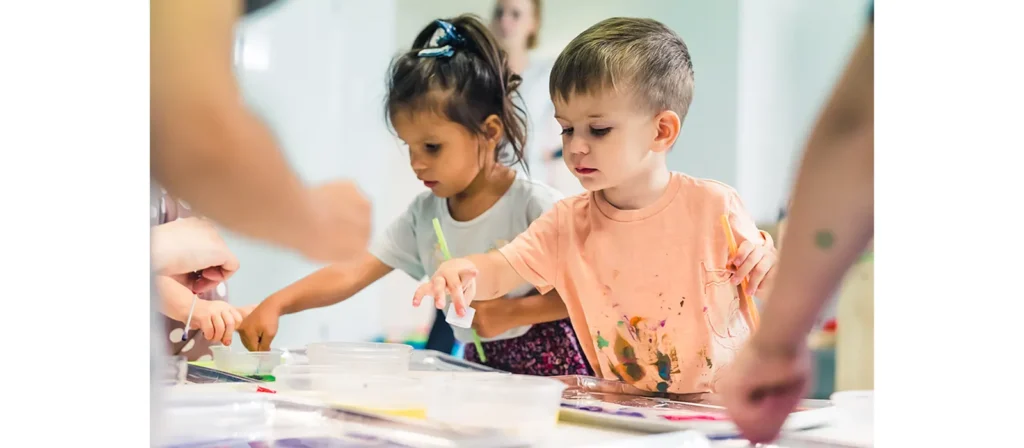
Kreatywność nie ogranicza się tylko do artystycznych przedsięwzięć — rozciąga się na wyobrażeniową zabawę, w której dzieci mogą eksperymentować z różnymi rolami i scenariuszami. Na przykład w klasie o tematyce baśniowej dziecko może udawać, że jest królem, rycerzem lub smokiem, eksplorując różne aspekty opowiadania historii i rozwoju postaci. Środowisko wypełnione żywymi dekoracjami i interaktywnymi elementami zachęca do marzeń, eksploracji i tworzenia.
Wspiera cele edukacyjne
Tematyczne zajęcia i dekoracje, takie jak te w przedszkolnej klasie o tematyce przyrodniczej, mogą być powiązane z celami programu nauczania, dzięki czemu lekcje są bardziej znaczące i zapadają w pamięć. Tematyczne przestrzenie edukacyjne pozwalają nauczycielom wprowadzać różne tematy, od podstawowych pojęć matematycznych, takich jak liczenie i kształty, po złożone tematy, takie jak środowisko lub historia ludzkości. Na przykład w klasie o tematyce przyrodniczej dzieci mogą brać udział w takich zajęciach, jak sadzenie nasion, sortowanie liści lub poznawanie cyklu życia motyla.
Te zajęcia można zaprojektować tak, aby odpowiadały konkretnym celom programu nauczania. Klasa o tematyce przyrodniczej może również zawierać rzeczywiste koncepcje, takie jak zrównoważony rozwój, zachęcanie dzieci do nauki o recyklingu, dbanie o rośliny lub zrozumienie ekosystemów. W ten sposób elementy tematyczne wspierają program nauczania, zamieniając abstrakcyjne koncepcje w namacalne, praktyczne doświadczenia, które są edukacyjne, zabawne i niezapomniane.
W jaki sposób tematy przyczyniają się do obszarów uczenia się
Tematy zajęć w przedszkolu to coś więcej niż tylko kreatywne tło; odgrywają integralną rolę w kształtowaniu doświadczeń edukacyjnych dziecka. Wplatając elementy edukacyjne w strukturę środowiska klasowego, tematy wzmacniają różne obszary rozwoju, takie jak umiejętności językowe, rozwój społeczny, matematyka i rozwój poznawczy. Oto podział tego, w jaki sposób tematy przyczyniają się do każdego z tych istotnych obszarów nauki:

Umiejętności językowe
Tematy zapewniają naturalny i angażujący kontekst do rozwijania umiejętności językowych dzieci. Na przykład, przedszkolna klasa o tematyce rolniczej oferuje niezliczone możliwości wprowadzenia nowego słownictwa. Od zwierząt, takich jak krowy, świnie i kury, po obiekty związane z gospodarstwem, takie jak stodoły, traktory i pola, każdy aspekt tematu staje się szansą dla dzieci na naukę i używanie nowych słów.
Opowiadanie historii, książki tematyczne i piosenki związane z tematem farmy mogą dodatkowo wzmocnić ten rozwój języka. Czy to czytanie książki o zwierzętach gospodarskich, czy śpiewanie piosenki o „Old MacDonald”, te zajęcia pomagają dzieciom budować znaczące i przyjemne słownictwo.
Ponadto tematy tworzą idealne środowisko do ćwiczenia struktury zdań i komunikacji. Dzieci mogą dzielić się historiami, zadawać pytania i rozmawiać z rówieśnikami na temat tematu, rozwijając w ten sposób swoje umiejętności werbalne w kontekście społecznym.
Matematyka
Matematyka nie musi być ograniczona do arkuszy kalkulacyjnych lub abstrakcyjnych liczb — może ożyć dzięki tematom klasowym. Na przykład, klasa przedszkolna w stylu tęczy zapewnia fantastyczną okazję do nauczania podstawowych pojęć matematycznych, takich jak kolory, wzory i sortowanie.
Dzieci mogą sortować przedmioty według koloru, liczyć różne kolory tęczy, a nawet mierzyć długość wstążek w kolorach tęczy. Ponadto motyw tęczy zachęca do eksploracji pojęć takich jak symetria, sekwencjonowanie oraz podstawowe dodawanie i odejmowanie. Na przykład możesz poprosić dzieci o wskazanie, ile czerwonych przedmiotów mogą znaleźć lub dodać liczbę kolorów na muralu tęczowym w klasie.
Poprzez włączanie działań związanych z matematyką do danego tematu, dzieci uczą się łączyć abstrakcyjne pojęcia ze światem wokół nich, co daje im solidne podstawy do przyszłej nauki matematyki.
Rozwój społeczny
Przedszkole to czas, w którym dzieci uczą się interakcji z rówieśnikami, a tematyka zajęć przedszkolnych pomaga ułatwiać te interakcje społeczne. Pod tematyką morską klasy przedszkolne zachęcają do aktywności grupowych, wspólnej zabawy i rozwiązywania problemów. Dzieci uczą się podstawowych umiejętności społecznych, takich jak współpraca, dzielenie się i branie udziału w kolejności, czy to udając stworzenia morskie, uczestnicząc w grupowym opowiadaniu historii, czy angażując się w projekty artystyczne oparte na współpracy, takie jak tworzenie dużego muralu oceanicznego.
Tematy są również doskonałym sposobem na zapoznanie dzieci z ważnymi koncepcjami społecznymi, takimi jak empatia i praca zespołowa. Na przykład w temacie „Pomocnicy społeczności” dzieci mogą odgrywać różne role pomocników społeczności — takich jak strażacy lub lekarze — pomagając im rozwinąć zrozumienie tego, jak ludzie współpracują, aby przyczynić się do dobrostanu innych. Poprzez angażowanie się w takie grupowe tematyczne działania, dzieci ćwiczą również aktywne słuchanie, dzielenie się swoimi pomysłami i rozwiązywanie konfliktów, co jest kluczowe dla rozwoju społecznego.
Rozwój poznawczy
Tematy zajęć w przedszkolu są bogatym źródłem stymulacji poznawczej, zachęcają do rozwiązywania problemów, myślenia krytycznego i kreatywności. Na przykład zajęcia w przedszkolu w tematyce kempingowej mogą obejmować różne zajęcia praktyczne, które stanowią wyzwanie dla zdolności poznawczych dzieci. Proste zajęcia, takie jak „rozpalanie ogniska” przy użyciu kolorowego papieru konstrukcyjnego lub organizowanie „eksploracji” z mapą udawanego lasu, mogą stymulować umiejętności rozwiązywania problemów u dzieci.
Dzieci mogą ćwiczyć pokonywanie wyzwań, takich jak wymyślanie, jak stworzyć namiot lub jak „znaleźć” pewne przedmioty na podstawie wskazówek. Te zajęcia pomagają dzieciom rozwijać umiejętności wykonawcze, takie jak planowanie, organizowanie i podejmowanie decyzji.
Ponadto tematy takie jak „eksploracja kosmosu” lub „odkrycie dinozaurów” mogą inspirować pytania napędzane ciekawością. Dzieci mogą chcieć wiedzieć, jak astronauci śpią w kosmosie lub co jadły dinozaury, co skłoni je do dalszych eksploracji za pomocą książek, zajęć praktycznych i dyskusji. Tematy oferują ustrukturyzowane, ale elastyczne środowisko, w którym dzieci mogą eksplorować, zadawać pytania i uczyć się w sposób, który wzmacnia ich rozwój poznawczy.
Kluczowe kwestie przy wyborze motywów do klas przedszkolnych
Wybór odpowiednich motywów do zajęć w przedszkolu wymaga zrównoważenia kreatywności, praktyczności i potrzeb rozwojowych. Nie chodzi tylko o to, aby pokój wyglądał ładnie — chodzi o stworzenie przestrzeni, która aktywnie wspiera rozwój dzieci, ich ciekawość i miłość do nauki.

Odpowiedniość do wieku: dostosowywanie tematów zajęć przedszkolnych do młodych umysłów
Pierwszą kwestią przy wyborze motywu klasy przedszkolnej jest zapewnienie, że jest on odpowiedni do wieku. Przedszkolaki są na etapie szybkiego rozwoju poznawczego i społecznego, więc motyw powinien odpowiadać ich poziomowi zrozumienia i ciekawości. Na przykład motyw dżungli angażowałby dzieci, wprowadzając zwierzęta, kolory i kształty, które mogą łatwo rozpoznać i zbadać. Odpowiednie do wieku motywy klas przedszkolnych pomagają wspierać ich naukę poprzez wskazówki wizualne i doświadczenia praktyczne, które odpowiadają ich etapom rozwoju.
Wszechstronność tematyczna: zachęcanie do różnorodnych możliwości uczenia się
Tematy zajęć w przedszkolu powinny dawać przestrzeń do eksploracji różnych obszarów tematycznych. Tematy zajęć w przedszkolu, które są zbyt wąskie, mogą ograniczać kreatywność, podczas gdy szerokie tematy, takie jak „środowisko” lub „transport”, mogą obejmować wszystko, od nauk ścisłych i matematyki po sztukę i język. Elastyczność pozwala na integrację różnych zajęć i materiałów edukacyjnych, zapewniając, że każdy zakątek klasy odzwierciedla możliwości rozwoju.
Rozważania nad przestrzenią: projektowanie dla wygody i ruchu
Rozmiar i układ klasy również odgrywają kluczową rolę w wyborze tematu. Niektóre motywy zajęć w przedszkolu mogą wymagać więcej przestrzeni fizycznej niż inne, zwłaszcza jeśli chcesz ustawić stacje lub centra, które wspierają różne aspekty tematu. Rozważ, czy temat pozwala na łatwe poruszanie się, czy też może tłoczyć przestrzeń, utrudniając dzieciom swobodną zabawę lub zajęcia grupowe.
Bezpieczeństwo przede wszystkim: priorytetem jest praktyczność i trwałość
Nie można pominąć kwestii bezpieczeństwa i praktyczności materiałów użytych w tym temacie. Upewnij się, że dekoracje, meble i wszelkie elementy tematyczne są bezpieczne dla małych dzieci — bez ostrych krawędzi, zagrożeń zadławienia lub toksycznych materiałów. Pomyśl również o trwałości przedmiotów. Tematy zajęć w przedszkolu, które obejmują materiały interaktywne, takie jak pojemniki sensoryczne lub ekspozycje ścienne, powinny być łatwe do czyszczenia i konserwacji.
Przyjazny dla budżetu: dopasowanie tematu do dostępnych zasobów
Podczas gdy motyw klasy przedszkolnej jest ważny, wybranie takiego, który pasuje do Twojego budżetu i dostępnych zasobów, jest równie istotne. Motywy klas przedszkolnych nie muszą być ekstrawaganckie ani drogie; wiele skutecznych motywów można wdrożyć za pomocą kreatywnych rozwiązań DIY, niedrogich dekoracji lub materiałów pochodzących z recyklingu. Upewnij się, że wybrany motyw nie wymaga więcej zasobów, niż możesz wygodnie zarządzać.
Promowanie inkluzywności: zapewnianie wrażliwości kulturowej
Niezbędne jest zapewnienie, że tematyka zajęć w przedszkolu odzwierciedla zróżnicowane i inkluzywne środowisko. Pamiętaj, że tematyka zajęć w przedszkolu odzwierciedla różne kultury, pochodzenie i perspektywy. Przedszkola powinny zapewniać inkluzywną przestrzeń, w której każde dziecko czuje się cenione i zauważone. Ta uwaga może pomóc w wyborze tematów, zapewniając, że promują one szacunek, zrozumienie i celebrację różnorodności.
Cele edukacyjne: dopasowanie tematów do celów edukacyjnych
Jednym z najważniejszych czynników przy wyborze tematów zajęć przedszkolnych jest to, jak dobrze pasują do celów edukacyjnych. Każdy temat powinien wspierać i wzmacniać program nauczania oraz umiejętności, które chcesz, aby dzieci rozwijały. Na przykład temat „gospodarstwa” może zachęcać do umiejętności matematycznych poprzez liczenie zwierząt, rozwój języka poprzez nazwy i dźwięki zwierząt oraz eksplorację naukową poprzez wzrost roślin. Temat, który łączy się z podstawowymi celami edukacyjnymi, wzmacnia ogólne doświadczenie edukacyjne, zapewniając, że dzieci angażują się w znaczącą, celową naukę.
Popularne motywy klas przedszkolnych
Tematy zajęć w przedszkolu mogą być dostosowane do zainteresowań i celów edukacyjnych nauczycieli i uczniów. Nauczyciele mogą sprawić, że nauka będzie przyjemniejsza i bardziej znacząca, tworząc angażujące i tematyczne środowisko. Oto kilka popularnych tematów, które okazały się bardzo skuteczne w wielu przedszkolach, oferując młodym uczniom zarówno zabawę, jak i możliwości edukacyjne:
1. Temat zajęć: Podwodne morze
Przekształć swoją klasę w podwodny raj za pomocą niebieskich ścian, wiszących papierowych ryb i koralowych dekoracji. Użyj serpentyn lub tkaniny, aby naśladować fale, i umieść w strefie zabaw zabawki w postaci zwierząt morskich, takich jak delfiny, żółwie i kraby. Pojemnik sensoryczny wypełniony piaskiem i muszlami może ożywić temat, jednocześnie ucząc dzieci o życiu morskim i ekosystemach.
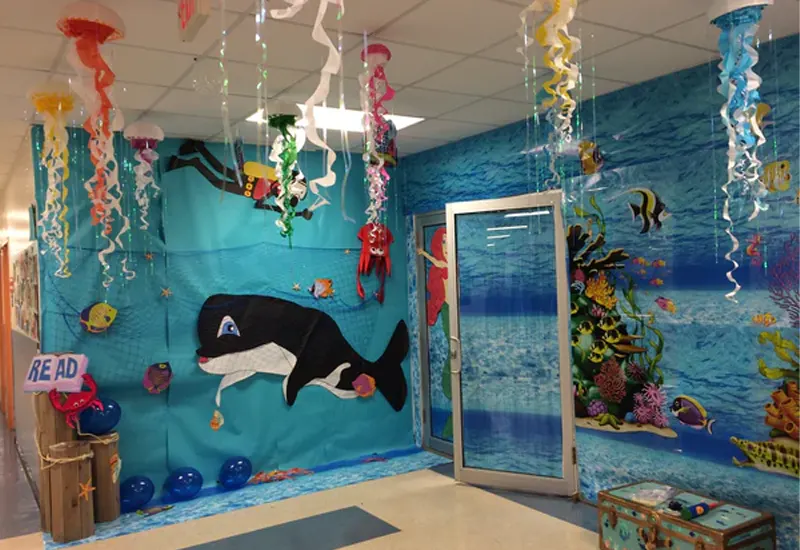
2. Klasa przedszkolna w stylu dżungli
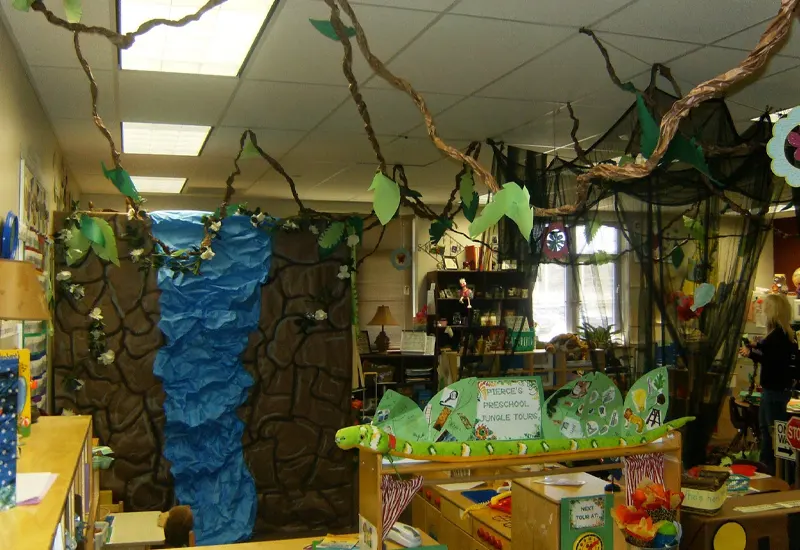
Stwórz bujne środowisko dżungli za pomocą zielonych papierowych winorośli zwisających z sufitu, wypchanych zwierząt z dżungli (takich jak małpy, lwy i papugi) oraz liściastych dekoracji ściennych. Użyj śladów zwierząt na podłodze jako zabawnego sposobu na oprowadzenie dzieci po klasie. Włącz opowiadanie historii za pomocą książek o dżungli i dodaj puzzle i gry ze zwierzętami z dżungli do interaktywnej nauki.
3. Temat klasy: Farma
Odtwórz scenerię farmy za pomocą bel siana, wycięć ze stodoły i obrazków zwierząt gospodarskich. Przygotuj „rynek rolny” dramatyczny plac zabaw z zabawkowymi warzywami i owocami. Dołącz zabawkowe traktory i figurki zwierząt, aby pomóc dzieciom odgrywanie ról życie na farmie. Dodaj piosenki i książki o tematyce rolniczej, aby wspierać rozwój języka.

4. Tęczowy motyw klasowy

Rozjaśnij swoją klasę żywym motywem tęczy. Udekoruj ściany tęczowymi serpentynami, papierowymi chmurami i dużym muralem tęczowym. Użyj kolorowych pojemników i półek, aby uporządkować materiały i wzmocnić rozpoznawanie kolorów. Aby pobudzić kreatywność, możesz również włączyć tęczowe rzemiosło, takie jak malowanie lub tworzenie papierowych tęcz.
5. Klasa o tematyce plażowej
Przenieś plażę do środka dzięki piaskownicy, piłkom plażowym i dekoracjom z muszelek. Udekoruj ściany obrazami oceanu, palm i parasoli plażowych. Przygotuj wycięcia na klapki na metki imienne i dodaj książki o tematyce wodnej do kącika czytelniczego. Stół sensoryczny z wodą i łódkami-zabawkami może uatrakcyjnić plażowe doznania.

6. Klasa o tematyce kosmicznej

Wystrzel w kosmos z ciemnoniebiesko-czarną kolorystyką, gwiaździstymi dekoracjami i wyciętymi rakietami. Zawieś świecące w ciemności gwiazdy na suficie i stwórz stację „Mission Control” z komputerami-zabawkami i przyciskami. Nauczaj o planetach za pomocą plakatów i pozwól dzieciom „eksplorować kosmos” za pomocą kostiumów astronautów.
7. Temat zajęć w klasie: kemping
Przygotuj mini kemping z namiotem, sztucznym ogniskiem i śpiworami. Użyj migoczących świateł, aby symulować gwiazdy i dodaj książki o tematyce outdoorowej, takie jak opowieści o przygodach na kempingu. Dramatyczny plac zabaw z zabawkowymi latarniami, udawanym sprzętem wędkarskim i naczyniami kempingowymi może pomóc dzieciom wyobrazić sobie wyprawę kempingową.

8. Temat klasy cyrkowej

Zmień swoją klasę w cyrk za pomocą jaskrawoczerwonych i żółtych dekoracji, wyciętych postaci klaunów i papierowych namiotów. Dołącz rekwizyty, takie jak piłki do żonglowania, figurki zwierząt i udawaną kasę biletową do odgrywania ról. Wprowadź zajęcia muzyczne i ruchowe o tematyce cyrkowej, takie jak udawanie akrobatów.
9. Tematy zajęć w przedszkolu w pracowni artystycznej
Zmień swoją klasę w kolorowe studio artystyczne z dekoracjami w postaci rozprysków farby, sztalugami i stanowiskami rzemieślniczymi. Zapewnij pędzle, markery, glinę i inne materiały do praktycznej kreatywności. Dołącz książki o tematyce artystycznej i zabawne zajęcia, takie jak wspólne murale lub odkrywanie znanych artystów. Zainspiruj wyobraźnię i miłość do sztuki!

10. Temat klasy superbohaterskiej
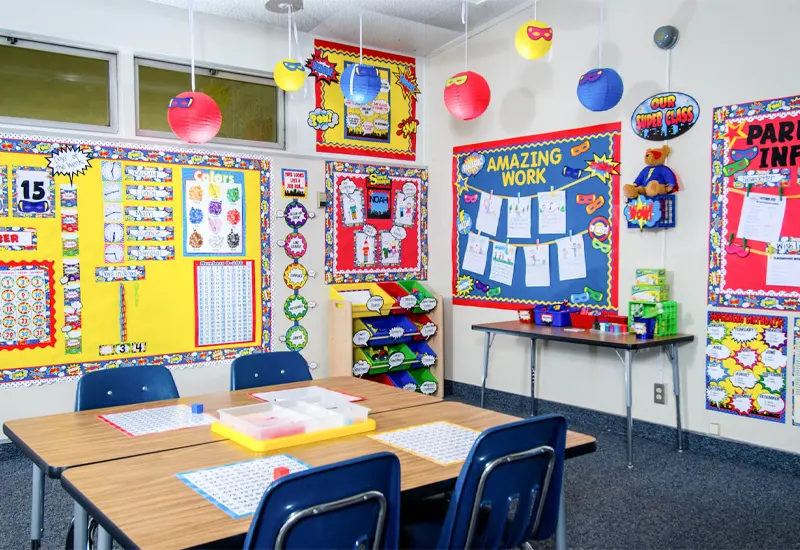
Zainspiruj dzieci motywem superbohaterów, który obejmuje peleryny, maski i „centrum szkolenia bohaterów”. Udekoruj plakatami w stylu komiksowym i jasnymi, wyrazistymi kolorami. Wykorzystaj aktywności o tematyce superbohaterów, takie jak tory przeszkód, aby promować rozwój fizyczny. Kładź nacisk na pracę zespołową i życzliwość, aby pomóc dzieciom identyfikować się z pozytywnymi cechami superbohaterów.
11. Temat klasy Dr. Seussa
Uczcij książki Dr. Seussa za pomocą fantazyjnych dekoracji z postaciami takimi jak Kot w kapeluszu i Lorax. Stwórz przytulny kącik do czytania z poduszkami i okładkami książek w stylu Seussa. Zaplanuj aktywności inspirowane Seussem, takie jak gry rymowane, aby zachęcić do rozwoju języka.
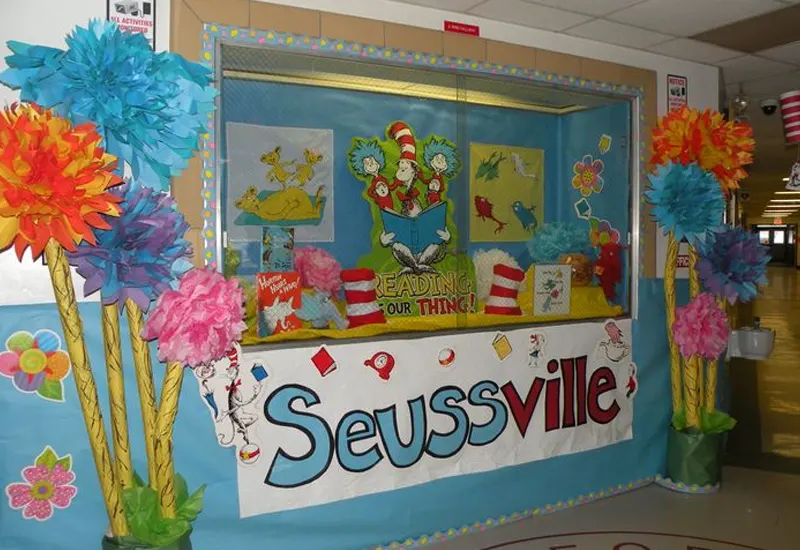
12. Transport Tematy zajęć przedszkolnych

Zaprojektuj motyw transportu z samochodzikami, samolotami, pociągami i znakami drogowymi. Użyj dywanu z wzorem drogi do zabawy i umieść plakaty przedstawiające różne rodzaje pojazdów. Przygotuj „warsztat mechaniczny” w strefie zabaw dramatycznych, w którym dzieci mogą udawać, że naprawiają samochody i rowery.
13. Tematy sezonowe (jesień, wiosna, zima, lato)
Obchodź pory roku za pomocą zmieniających się dekoracji. Na jesień dodaj liście, dynie i strachy na wróble. Zimą mogą być płatki śniegu i przytulne kąciki, a wiosną kwiaty i motyle. Letnie motywy zajęć przedszkolnych mogą obejmować słońce i piknikowe otoczenie. Użyj sezonowych rękodzieł, aby odzwierciedlić zmiany w naturze.

14. Tematy zajęć przedszkolnych w Dinosaur Paradise
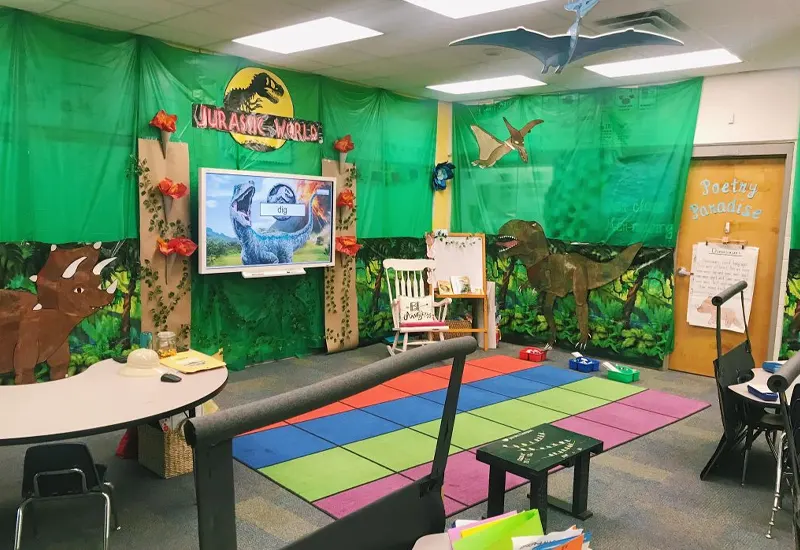
Dinozaury to ekscytujący temat dla małych dzieci, a ten temat pobudzi ich wyobraźnię, gdy będą odkrywać te starożytne stworzenia. Dzieci dowiedzą się o różnych typach dinozaurów, ich siedliskach i prehistorycznym świecie, w którym żyły. Ten temat oferuje mnóstwo zajęć praktycznych, takich jak tworzenie rzemiosł z dinozaurami, kopanie w poszukiwaniu „skamieniałości” i odgrywanie ról paleontologów.
15. Tematy zajęć sportowych w przedszkolu
Przekształć swoją klasę w klasę sportową, wykorzystując plakaty, mini bramki i dekoracje piłek. Przygotuj stanowiska do koszykówki, kręgli i rzucania woreczkami. Użyj sprzętu sportowego jako dekoracji i dołącz tematyczne książki i zajęcia zespołowe, aby zainspirować zabawę i ruch!

16. Tematy zajęć w klasie na Dzień Ziemi
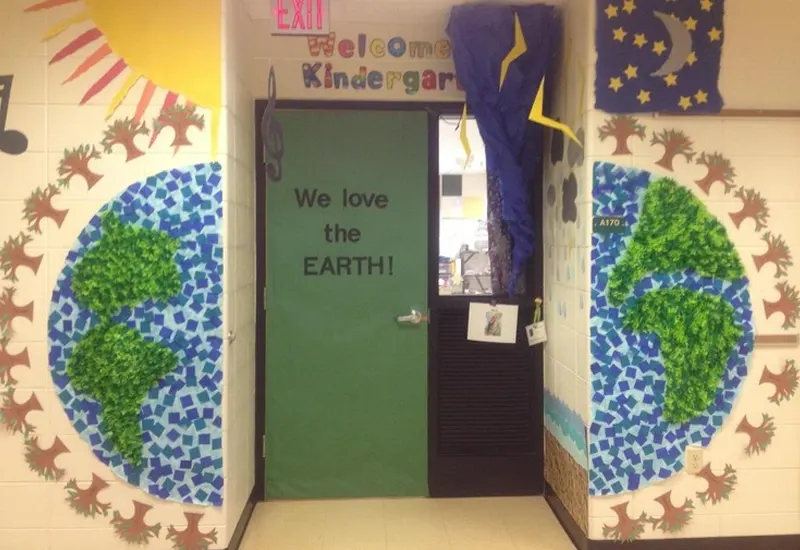
Temat Dnia Ziemi pomaga dzieciom dowiedzieć się, jak ważne jest dbanie o naszą planetę. Klasa może być wypełniona zajęciami skupionymi na recyklingu, oszczędzaniu energii i zrozumieniu natury. Nauczyciele mogą włączyć projekty uprawy roślin, spacery po przyrodzie i proste lekcje o zanieczyszczeniu i zmianie klimatu. Celem jest wczesne promowanie odpowiedzialności za środowisko przy jednoczesnym promowaniu miłości do Ziemi i wszystkich jej stworzeń.
17. Tematy zajęć: Robaki i owady
Świat owadów i insektów jest fascynujący dla młodych uczniów, a ten temat pozwala im odkrywać małe stworzenia, które żyją wokół nas. Temat Bugs and Insects może obejmować naukę o różnych rodzajach owadów, ich siedliskach i ich rolach w przyrodzie. To doskonała okazja do wprowadzenia pojęć biologii, cykli życia i siedlisk.
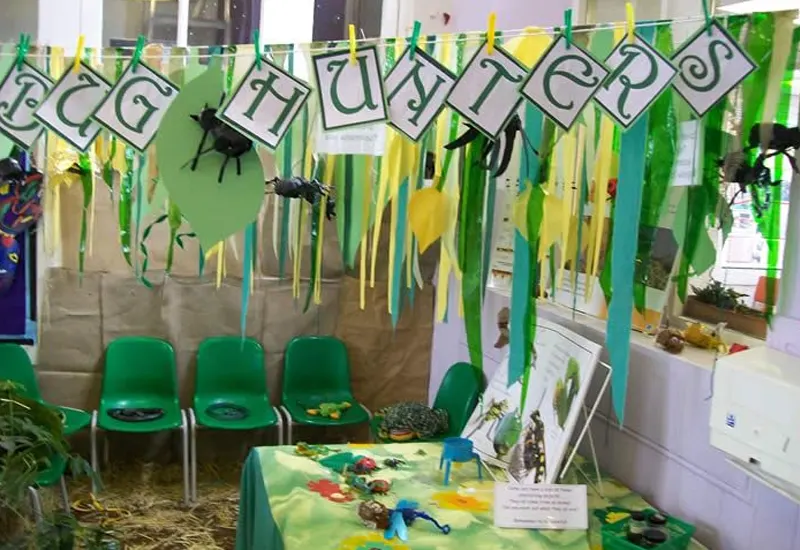
18. Tematy zajęć przedszkolnych na temat bezpieczeństwa pożarowego
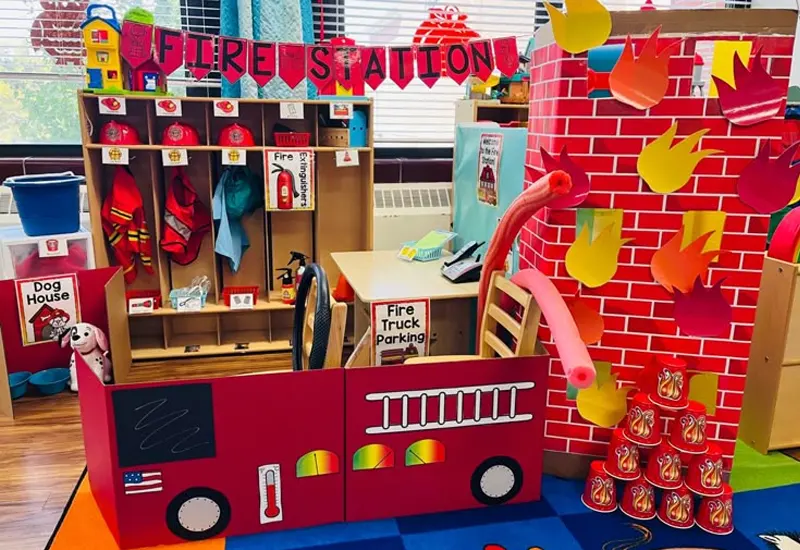
Bezpieczeństwo przeciwpożarowe to kluczowy temat do zrozumienia dla małych dzieci. Ten temat został zaprojektowany, aby nauczyć dzieci znaczenia bezpieczeństwa przeciwpożarowego i tego, jak reagować w nagłych wypadkach. Klasa może obejmować lekcje dotyczące zapobiegania pożarom, podstawowych zasad bezpieczeństwa przeciwpożarowego i roli strażaków w naszej społeczności. Ten angażujący i edukacyjny temat łączy naukę z zabawą poprzez piosenki, odgrywanie ról i ćwiczenia bezpieczeństwa.
19. Muzyka i ruch w klasach przedszkolnych
Temat Muzyka i ruch zachęca dzieci do wyrażania siebie poprzez taniec, muzykę i rytm. Ten temat koncentruje się na poprawie umiejętności motorycznych, rytmu, koordynacji i pracy zespołowej. Nauczyciele mogą włączyć różne gatunki muzyczne, gry ruchowe i instrumenty do codziennych zajęć. Nie chodzi tylko o słuchanie muzyki — dzieci będą również aktywnie uczestniczyć w tworzeniu dźwięków, wzorów rytmicznych i choreograficznych tańców.
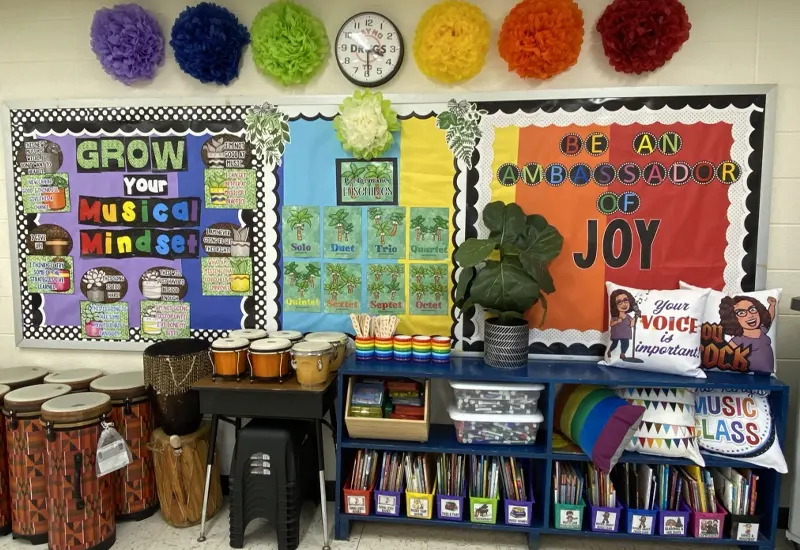
20. Tematy zajęć przedszkolnych Donut

Temat Donut Classroom oferuje słodki i zabawny sposób na zaangażowanie dzieci w naukę. Ponieważ pączki są popularnym przysmakiem, ten temat może skupić się na kształtach i kolorach, a nawet wprowadzić zdrowe nawyki żywieniowe. Nauczyciele mogą wykorzystać ten temat, aby omówić, jak powstają pączki i ich różne smaki, dodając jednocześnie zabawne lekcje matematyki i nauk ścisłych na temat robienia pączków.
21. Tematy zajęć przedszkolnych w ogrodzie
Temat Garden Classroom daje dzieciom praktyczne doświadczenia z naturą. Wprowadza je w cuda roślin, ogrodnictwa i ekosystemu. Ten temat pielęgnuje uznanie dla środowiska i uczy dzieci odpowiedzialności za dbanie o rośliny. Mogą obserwować, jak rosną rzeczy, jak rośliny potrzebują światła słonecznego i wody oraz czego różne rośliny potrzebują, aby się rozwijać.

22. Wszystko o mnie Tematy klas przedszkolnych
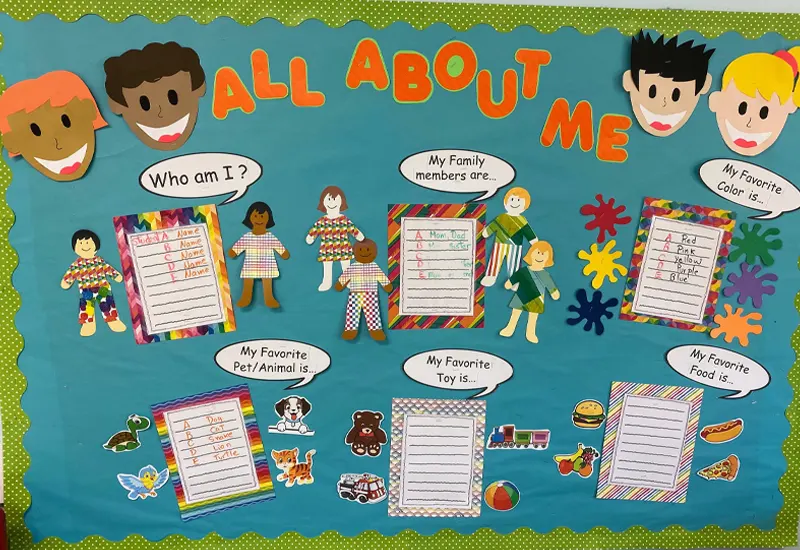
Motyw All About Me koncentruje się na tworzeniu przyjaznego, inkluzywnego i spersonalizowanego środowiska studenckiego. Pozwala dzieciom poznać swoją klasę, kolegów z klasy i codzienne rutyny. Ten motyw może pomóc dzieciom poczuć się bardziej komfortowo w swojej przestrzeni edukacyjnej, zrozumieć znaczenie szacunku i współpracy oraz podkreślić swoją wyjątkowość.
23. Tematy zajęć w ramach programu „Pomocnicy społeczności”
Ten temat koncentruje się na ważnych osobach, które pomagają w funkcjonowaniu naszych społeczności, takich jak strażacy, lekarze, policjanci i nauczyciele. Dzieci zrozumieją te zawody i to, w jaki sposób każdy pomocnik społeczności przyczynia się do dobrobytu społeczeństwa. Poprzez angażowanie się w odgrywanie ról i działania praktyczne dzieci lepiej docenią wartość tych codziennych bohaterów.
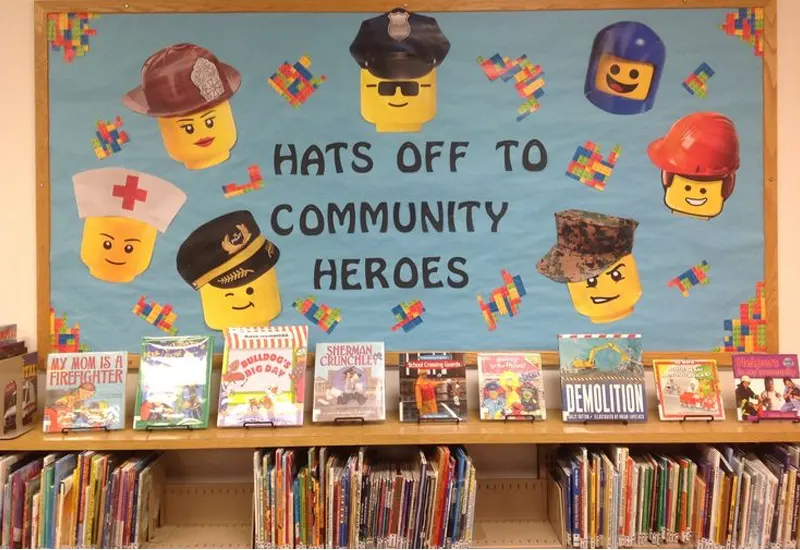
24. Tematy zajęć przedszkolnych na temat żywienia
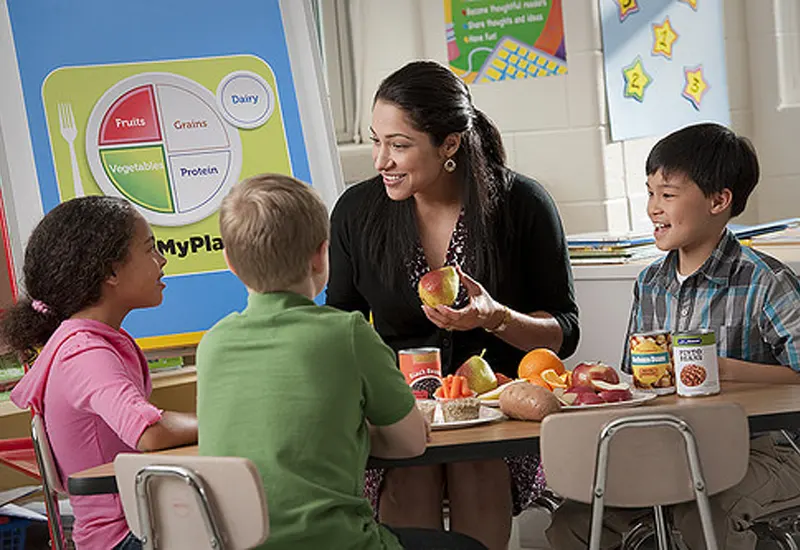
Temat zajęć z żywienia został zaprojektowany, aby wprowadzić małe dzieci do świata zdrowego odżywiania i dobrych wyborów żywieniowych. Dzięki temu tematowi dzieci uczą się o znaczeniu zrównoważonej diety, zrozumieniu grup żywności i wpływie żywności na nasze zdrowie i poziom energii. Skupia się na nauczaniu dzieci, jak dokonywać zdrowszych wyborów żywieniowych, a temat może obejmować zabawne, interaktywne działania, takie jak planowanie posiłków, sortowanie żywności i przygotowywanie zdrowych przekąsek.
25. Alfabet w przedszkolu Tematy klasowe
Temat Alphabet Classroom to zabawny i interaktywny sposób na wprowadzenie przedszkolaków do świata liter i słów. Temat ten koncentruje się na pomocy dzieciom w rozpoznawaniu, identyfikowaniu i uczeniu się dźwięków każdej litery alfabetu. Dzieci będą rozwijać podstawowe umiejętności czytania i pisania poprzez gry, zajęcia, piosenki i prace plastyczne. Celem jest uczynienie nauki alfabetu przyjemną i angażującą, pobudzając ciekawość dzieci w zakresie języka i komunikacji.
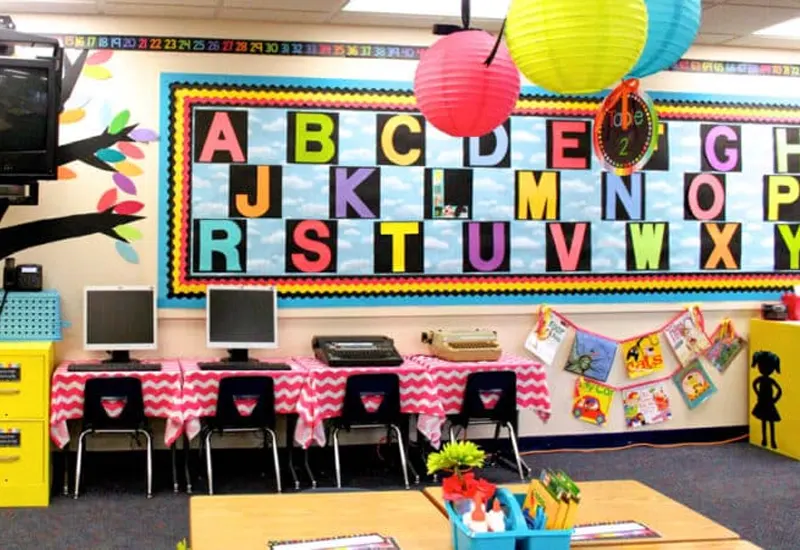
26. Maniery Tematy zajęć w przedszkolu
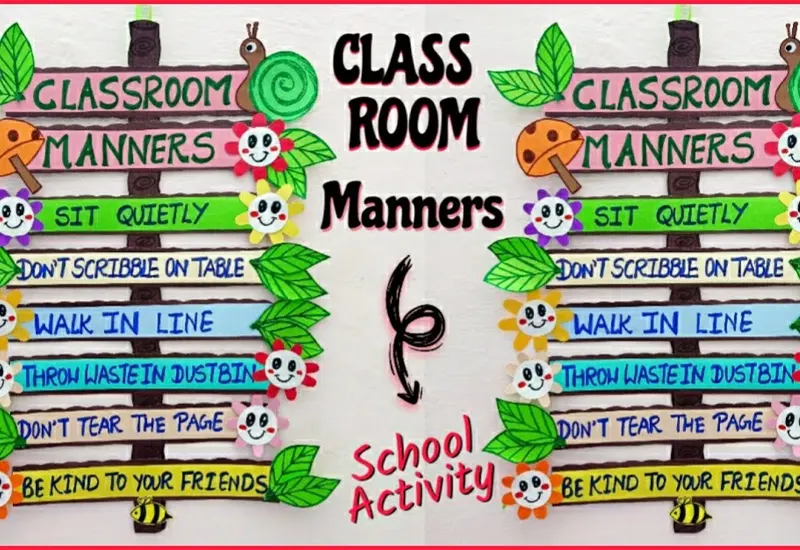
Temat Manners Classroom koncentruje się na nauczaniu małych dzieci znaczenia dobrych manier, szacunku i etykiety społecznej. Ten temat pomaga przedszkolakom nauczyć się, jak pozytywnie wchodzić w interakcje z innymi, podkreślając życzliwość, uprzejmość i szacunek dla innych. Poprzez eksplorację takich pojęć, jak mówienie „proszę” i „dziękuję”, czekanie na swoją kolej i używanie języka szacunku, dzieci zdobywają niezbędne umiejętności społeczne, które przyniosą im korzyści przez całe życie.
27. Tematy zajęć przedszkolnych w zakresie budownictwa
Temat Construction Classroom to ekscytujący sposób na zaangażowanie przedszkolaków w praktyczną naukę o budowaniu, pracy zespołowej i kreatywności. Temat ten koncentruje się wokół placów budowy, materiałów budowlanych i narzędzi, których używają budowniczowie i inżynierowie. Dzieci będą poznawać świat budownictwa poprzez kreatywną zabawę, wyzwania inżynieryjne i zajęcia promujące umiejętności rozwiązywania problemów.
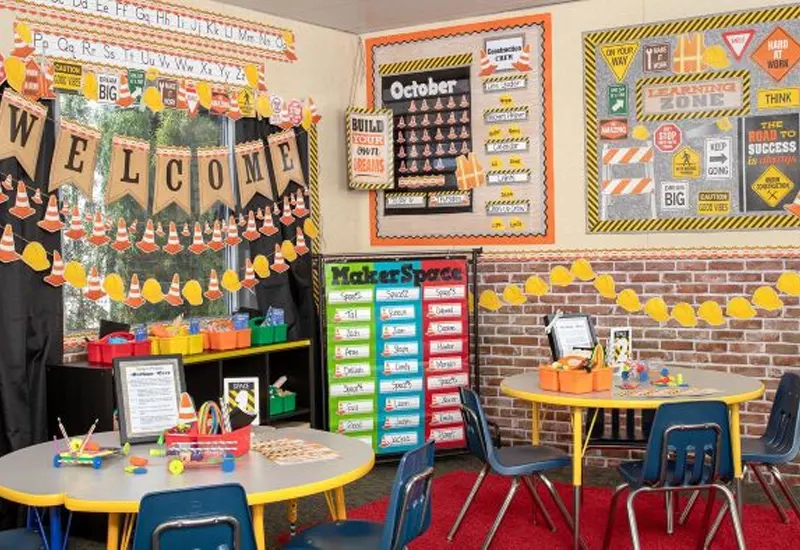
28. Tematy zajęć w klasach: Domy i mieszkania

Temat klasy Houses and Homes wprowadza przedszkolaków w koncepcję domów i różnych typów domów, w których mieszkają ludzie. Ten temat bada różne cechy i funkcje domów, różne typy domów na całym świecie oraz znaczenie społeczności i rodziny. Poprzez angażowanie dzieci w działania, które obejmują budowanie, dekorowanie i zrozumienie celu różnych typów domów, ten temat pomaga młodym uczniom rozwijać poczucie przynależności i docenianie miejsca, w którym mieszkają.
Jak włączyć wybrany temat do zajęć w klasie
Włączanie wczesne dzieciństwo przedszkolne tematy klasowe zaczyna się od przekształcenia przestrzeni fizycznej, aby odzwierciedlała wybraną koncepcję. Zacznij od udekorowania ścian tematycznymi wizualizacjami, takimi jak murale, plakaty lub wycinanki, które pasują do Twojego motywu. Dodaj zawieszki sufitowe lub kolorowe serpentyny, aby ulepszyć otoczenie. Na przykład w motywie „Pod morzem” możesz użyć niebieskiego papieru, aby naśladować wodę, wyciętych ryb dla życia morskiego i serpentyn, aby stworzyć wygląd fal. Wyznacz obszary w klasie na określone zajęcia, które są zgodne z motywem, takie jak stół sensoryczny, kącik do czytania lub stacja do zabawy dramatycznej.
Następnie włącz elementy tematyczne do codziennych lekcji i zajęć. Na przykład użyj tematu, aby nauczyć podstawowych pojęć: liczenia zwierząt gospodarskich do matematyki w temacie „Farm” lub nauki nowego słownictwa z nazwami dinozaurów w temacie „Dinosaur Paradise”. Dopasuj książki, rękodzieło i zabawki do tematu, aby wzmocnić naukę. Dołącz praktyczne, interaktywne elementy, takie jak wykopaliska skamieniałości, udawane targi rolników lub tworzenie modeli wulkanów, aby uczynić doświadczenie wciągającym i angażującym.
Na koniec upewnij się, że motyw wspiera cele rozwojowe i jest dostępny dla wszystkich dzieci. Używaj bezpiecznych, odpowiednich do wieku materiałów i zapewnij możliwości eksploracji i kreatywności. Poprzez przemyślane łączenie tematycznych dekoracji, lekcji i zajęć możesz stworzyć ekscytujące i edukacyjne środowisko, które będzie sprzyjać uczeniu się i ciekawości u Twoich przedszkolaków.
Wskazówki dotyczące skutecznego wdrażania motywów zajęć w przedszkolu
Skuteczne wdrażanie tematów zajęć przedszkolnych polega na uczynieniu środowiska angażującym i edukacyjnym, a jednocześnie zapewnieniu, że wspiera ono cele rozwojowe. Oto kilka praktycznych wskazówek:
- Zaplanuj z wyprzedzeniem: Przed uruchomieniem motywu przygotuj materiały, zajęcia i ekspozycje. Utwórz listę kontrolną swoich dekoracji, książek, rękodzieła i materiałów. Przygotowanie wszystkiego z wyprzedzeniem zapewnia płynny start.
- Zachowaj interaktywność: Skup się na praktycznych zajęciach, które pozwolą dzieciom eksplorować temat. Na przykład ustaw stację wykopalisk skamieniałości w temacie „Raju dinozaurów” lub pozwól dzieciom tworzyć własne dinozaurowe rękodzieła. Praktyczna zabawa sprzyja głębszemu zaangażowaniu i wspiera rozwój umiejętności.
- Połącz naukę z zabawą: Użyj tematu jako trampoliny do nauczania podstawowych umiejętności. Na przykład temat „Kosmos” może obejmować liczenie planet dla matematyki, opowiadanie historii o astronautach dla rozwoju języka i proste eksperymenty naukowe dotyczące grawitacji.
- Stwórz doświadczenie wielozmysłowe: Włącz elementy wizualne, słuchowe i dotykowe do motywu. W przypadku motywu „Tęcza” uwzględnij kolorowe dekoracje, piosenki o tęczy i projekty artystyczne z wykorzystaniem farby lub papieru. Aktywności multisensoryczne sprawiają, że motyw jest bardziej zapadający w pamięć.
- Dostosuj do zainteresowań dzieci: Obserwuj, jak dzieci reagują na różne aspekty tematu i dostosowuj je w razie potrzeby. Jeśli uwielbiają pewne aktywności, rozwijaj je. Jeśli pewne elementy nie są angażujące, zastąp je lub zmodyfikuj.
- Utrzymuj porządek: Unikaj bałaganu, organizując materiały tematyczne w jasno określonych przestrzeniach. Używaj pojemników lub półek do przechowywania zabawek, książek i materiałów związanych z tematem. Oznacz je obrazkami lub słowami, aby były dostępne dla młodych uczniów.
- Zaangażuj rodziny: Rozszerz temat poza klasę, angażując rodziców. Wyślij do domu pomysły na tematyczne aktywności lub zestawy do majsterkowania, aby wzmocnić naukę. Na przykład w temacie „Gospodarstwo” zachęcaj rodziców, aby pomagali dzieciom identyfikować warzywa w domu lub w sklepie spożywczym.
Utrzymywanie i aktualizowanie motywów zajęć w przedszkolu
Utrzymywanie świeżych i angażujących tematów zajęć w przedszkolu jest niezbędne do utrzymania zainteresowania i ekscytacji dzieci. Oto, jak to zrobić skutecznie:

- Regularnie odświeżaj wystrój: Choć główny motyw pozostaje ten sam, co kilka tygodni zmieniaj dekoracje lub dodawaj nowe elementy. Na przykład, w przypadku motywu „Natura”, zaktualizuj ekspozycje ścienne, aby odzwierciedlały zmieniające się pory roku, np. dodając wiosenne kwiaty lub jesienne liście.
- Rotacja aktywności: Wprowadzaj nowe aktywności lub wyzwania w miarę rozwoju tematu. Na przykład w temacie „Kosmos” zacznij od nauki o planetach, a później przejdź do gwiazd i konstelacji. Zmieniające się aktywności zapewniają dzieciom ciekawość i zaangażowanie.
- Uwzględnij aktualizacje sezonowe: Dopasuj tematykę zajęć przedszkolnych do pory roku, aby zwiększyć trafność. Na przykład, w przypadku tematu „Plaża” latem, uwzględnij słoneczne dekoracje i zabawę w wodzie. Dostosuj temat „Kemping” zimą, aby skupić się na namiotach w pomieszczeniach i udawanym ognisku.
- Oceń zaangażowanie: Zwróć uwagę na to, jak dzieci wchodzą w interakcję z tematem. Czy eksplorują i zadają pytania? Czy pewne materiały lub obszary są niedostatecznie wykorzystywane? Wykorzystaj te obserwacje, aby dostosować lub dodać elementy, które lepiej przyciągną ich uwagę.
- Utrzymuj czystość i funkcjonalność: Elementy tematyczne mogą szybko się zużywać w przedszkolu. Regularnie czyść i organizuj materiały, aby zapewnić ich bezpieczeństwo i atrakcyjność. Wymieniaj lub naprawiaj przedmioty w razie potrzeby, aby utrzymać funkcjonalność klasy.
- Wprowadź aktualizacje współpracy: Pozwól dzieciom pomóc w aktualizacji tematu poprzez tworzenie prac ręcznych lub wnoszenie pomysłów. Na przykład podczas tematu „Tęcza” niech wykonają kolorowe dzieła sztuki do powieszenia na ścianach lub zaprojektują swoje wzory tęczy.
- Przełączanie między motywami: Zmień tematykę zajęć przedszkolnych co 4-6 tygodni, aby zachować dynamikę. Na przykład po zakończeniu tematu „Dinozaur” przejdź do „Pod morzem”. Zapobiega to monotonii i wprowadza nowe możliwości uczenia się.
Wniosek
Podsumowując, wybór odpowiedniego motywu zajęć w przedszkolu to coś więcej niż tylko wybór estetyczny — to okazja do wspierania kreatywności, nauki i rozwoju. Tworzysz środowisko, w którym dzieci mogą odkrywać, angażować się i rozwijać podstawowe umiejętności, wybierając motywy zajęć w przedszkolu, które są odpowiednie do wieku, wszechstronne i zgodne z celami edukacyjnymi. Niezależnie od tego, czy jest to motyw inspirowany naturą, czy podróż przez kosmos, odpowiednia atmosfera może pobudzić ciekawość, zbudować pewność siebie i zainspirować młode umysły do wielkich marzeń i nauki poprzez zabawę.
Nie wahaj się skontaktować z nami, aby uzyskać więcej informacji na temat tematów zajęć w klasach przedszkolnych! Jesteśmy tutaj, aby pomóc Ci wybrać idealny motyw dla Twojej klasy i zaprojektować układ które sprzyja nauce i zabawie. Pozwól nam pomóc Ci stworzyć inspirujące środowisko, które oczaruje i zmotywuje Twoich młodych uczniów!

